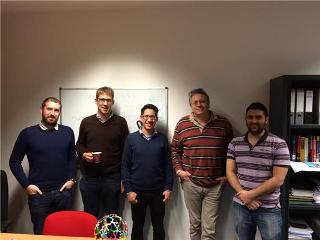Jan 29 2015
Collaboration in a project to create a catalog of different materials and combining them to obtain a metamaterial (artificial material) with the desired characteristics.

Mexican Andrés R. Botello-Méndez, resides in Belgium and does research on graphene and other two-dimensional materials (2D) to increase awareness of their physical and chemical properties. He also collects information that could be applied in the short-term to creating touchscreens or transparent conductors.
The industrial physics engineer by the Tecnológico de Monterrey (ITESM), said his research lies in studying materials with reduced dimensions (1D, 2D) from the perspective of the simulation through computer-based experiments, using the freeware ABINIT, with the aim of increasing the understanding of the physical chemistry properties of these materials.
To do this, the research team used the Density Functional Theory (DFT), which describes the materials from the point of view of quantum mechanics. The theory, via software, works in the reduction of the complicated problem various bodies encounter when faced with electron density, which minimizes the potential energy described by the system, and which happens to be its fundamental state.
Botello-Méndez, member of the Mexican Talent Network, Chapter Belgium, said, when asked about his stay abroad; "For me, science has no borders, is something I learned in San Luis Potosi (center north state of Mexico). It is a human and collective activity, where borders have little meaning. Many of my projects are in collaboration with people in other countries, laboratories in Brazil, the US, India and around Europe, and it makes me proud to say that my training is 100 percent Mexican."
He also mentioned that the goal of the team from the Institute of Condensed Matter and Nanosciences at the Catholic University of Louvain (UCL), where he has worked for the last five years, is to create a catalog of different two-dimensional materials with different properties and group them, to have a metamaterial (artificial material) with the desired characteristics. He added that although metamaterials don’t have specific applications yet, research can help find their usefulness for society.
The integration of graphene and other two-dimensional materials to electronics will not be simple, in spite of being compatible with the manufacturing methods. The problem is that they have unconventional physical properties due to quantum effects (behavior of matter at atomic scales)which in the case of silicon have been tried to avoid when making it smaller, said Botello-Méndez, who holds a PhD by the Institute of Scientific and Technological Research (IPICYT).
The UCL team, part of the consortium Graphene Flagship, is one of the most important research initiatives of the European Union, which also works on the properties of hexagonal boron nitride, "near relative" of the graphene, and on the dichalcogenides of transition metals, with different electrical and optical characteristics.
"By analyzing their quantum phenomena we could open the way to new and exotic technologies," concluded the Mexican researcher.
Source: http://www.invdes.com.mx/